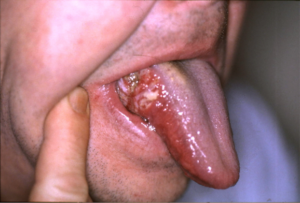
Picture source: https://en.wikipedia.org/wiki/Oral_cancer
Quick question for you, what is the cancer that is:
- Sixth most common in the world?
- Highly associated with tobacco smoking, betel quid chewing and excessive alcohol consumption?
- Third most common cancer among Malaysian Indian community in Malaysian Ministry of Health Hospitals?
Yes, you guessed it right. The answer is oral cancer.
Oral cancer is an abnormal growth found in the mouth region.
The next thing is, why should you (we) care?
Because we all fall into one of these 3 types of people.
- a) We know somebody who has it. So learn about the treatment options.
- b) We suspect we have it. So learn how to check for it.
- c) We think we don’t have it. So learn how to take precautions against it.
Let’s view things from each perspective.
- a) You know somebody with oral cancer
Heard of your relative or friend with a tongue cancer that needs to have the tongue removed?
Oral cancer patients are referred to oral cancer centers from general medical or dental practice, with typical signs and symptoms, including white or red patches in the mouth, persistent sores, and bleeding. The primary treatment modality is surgery, with or without post-operative radiotherapy / chemotherapy.
Surgery is performed to remove only the tumor or the entire organ. Radiotherapy is often used as an additional therapy following surgery, to help destroy residual microscopic cancer cells that may have been missed. Chemotherapy is the use of anticancer drugs usually administered by injection and requires the patient to stay in the ward.
Patients who have had mouth cancer must be closely monitored to make sure that the cancer does not return. Survival rates have improved over the last 20 years and if cancer is caught early it can be cured. With the right care, cancer patients can have a good quality of life.
- b) You suspect of having oral cancer
There’s been an ulcer going on in your mouth for past 2 weeks and it’s now showing signs of healing.
Do you have these issues recently?
- Persistent mouth sore
- Pain in mouth or ear
- Chronic hoarseness
- Non-tender lump in neck
- Abnormal swallowing
- Peculiar sore throat
Go through the 6 steps of screening
Step 1: Tongue ‘n Gauze
Extend your tongue as far as it can go, examining the sides and underside for white and red patches, and feels your tongue for lumps. NOTE: This is the most common site of oral cancers in non-smokers.
Step 2: Lip & Cheek Roll
Feel for lumps or bumps, looking for white or red areas that should not be there.
Step 3: Double-Digit Probe
Examine the floor of your mouth from the top and bottom simultaneously for lumps, looking for white and red patches.
Step 4: Palate Tickle
Check the roof of your mouth for lumps and areas of softness on the hard palate, looking for white and red patches.
Step 5: Neck Caress
Palpate your neck for enlarged lymph nodes a possible sign of infection or something more serious.
Step 6: Tonsil “Ahhhhhhh”
Depress your tongue with a dental mirror, examining your tonsils for symmetry, enlargement, redness, or unusual bumps.
There’s a 8-step screening version as well. So long as you perform the screenings properly.
- c) You think you don’t have oral cancer.
That’s great, therefore, maintain it by staying away from risk factors that would increase your chances of developing life-threatening oral cancer.
Risk factors include:
- Smoking (smoke 3 boxes of cigarettes a day? Time to reconsider)
- Alcohol (always be having 6 Pack Beers daily? Why take the risk?)
- Betel quid (you’re better off chewing chewing gum instead, seriously)
- Pre-malignant lesions in the oral cavity such as lichen planus. (It means white lines or ulceration in the oral cavity)
- Immunosuppression (e.g. HIV)
In a nutshell, let us Malaysians be educated in features of an early oral cancer lesion and recurrence, be encouraged to monitor for it regularly. Seek a dentist if you suspect anything weird happening in your mouth. Usually, it appears as a non-healing ulcer (shows no sign of healing after 2 weeks)
Dr. Edward Tay is a dentist with an interest in preventive dentistry and empowering others in oral self-care. This article is published in conjunction with Mouth Cancer Action Month.
References:
- https://www.sixstepscreening.org/oral-cancer/
- http://oralcancerfoundation.org/
- Cawson, R. A., & Odell, E. W. (2008). Cawson’s essentials of oral pathology and oral medicine. Edinburgh: Churchill Livingstone.
[This article belongs to The Malaysian Medical Gazette. Any republication (online or offline) without written permission from The Malaysian Medical Gazette is prohibited.]
